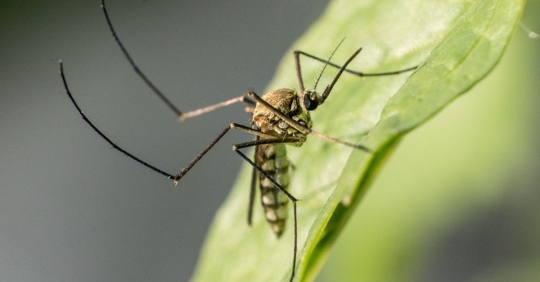Presence of Mosquito Larvae in Stagnant Water
One of the most telling signs of a mosquito infestation begins long before these pesky insects become a nuisance to humans. Mosquitoes lay their eggs in stagnant water, making places like ponds, bird baths, and clogged gutters prime real estate for breeding. If you notice small, wriggling larvae in these water sources, it's a clear indication that your home or garden is playing host to future generations of mosquitoes. These larvae are often overlooked because they're small and blend easily in water. However, finding them should act as a red flag for homeowners to address potential breeding grounds before they transform into a full-fledged mosquito population.
Understanding the life cycle of mosquitoes is critical in highlighting how crucial these larvae are in identifying an infestation. The presence of mosquito larvae in any standing water source nearby signals that adult mosquitoes have found a suitable breeding habitat, something every homeowner should be keenly aware of. By regularly inspecting and eliminating standing water on your property, you not only interrupt the life cycle of mosquitoes but also significantly reduce the likelihood of an infestation taking root. It's not just about thwarting their breeding sites, but also proactively managing and maintaining your property for long-term control.
Increase in Mosquito Bites
Another unmistakable symptom of mosquito infestation is the increase in mosquito bites. These bites not only lead to discomfort but also pose a legitimate health risk. Mosquitoes are most active during dawn and dusk, and if you're waking up or winding down with more frequent itchy bites, it's likely you've got a mosquito problem on your hands. These bites typically manifest as small, itchy welts on the skin, often accompanied by redness and swelling. For individuals with sensitive skin, the annoyance is even more significant, potentially leading to infections or allergic reactions if not properly cared for.
Analyzing the pattern and frequency of bites can provide insights into the severity of the mosquito presence in your vicinity. The annoyance and potential health risks posed by these bites signify an urgent need for intervention. Recognizing early signs and taking prompt action through preventive and mitigative measures can protect against the oppressive irritation and potential disease transmission caused by these insects. Whether it's employing repellents, ensuring screened windows and doors, or seeking professional pest control, taking steps to reduce mosquito bites can restore peace and comfort in your home environment.
Frequent Sightings Indoors and Outdoors
Frequent sightings of mosquitoes, both indoors and out, are yet another telling sign of infestation. Inside the home, you might notice these insects hovering near lights, windows, and even around plants. Their tiny, agile bodies often go unnoticed until they start buzzing around your ears or biting. This indoor presence usually suggests that mosquitoes have found entry points like unscreened doors and windows or tiny cracks and crevices. Outdoor sightings may also escalate during warmer seasons when mosquitoes are seeking hosts for feeding and breeding.
The frequency of these sightings tends to increase with seasonal changes and specific environmental conditions conducive to mosquito life cycles. Summer months, in particular, bring about heightened mosquito activity, given the warm and humid climate, which is just right for them. Beyond summer, factors like rain and the subsequent pooling of water can create ideal conditions for mosquitoes to thrive. Homeowners should be proactive by securing homes against entry points and minimizing outdoor conditions that attract mosquitoes, thus curbing both indoor and outdoor sightings.
Standing Water and Poor Drainage Areas
Household features and garden elements prone to collecting water can unwittingly become mosquito magnets. Standing water, often found in neglected pots, bird baths, or mismanaged drainage systems, offers an idyllic setting for mosquito breeding. Without proper water management, these areas can quickly teem with larvae, essentially setting the stage for a burgeoning mosquito infestation. Homeowners should be vigilant in checking these potential hotspots regularly, dumping water where unnecessary, and ensuring efficient drainage to prevent water from stagnating.
Guidelines for effective water management are crucial to reducing mosquito breeding opportunities. This includes keeping gutters clean, frequently changing water in bird baths, and using mosquito-proof lids on water storage tanks. In the garden, uneven landscapes where water tends to pool should be leveled out, and plant saucers should be cleared of excess water regularly. Through practical water management practices, you can significantly diminish mosquito breeding sites, safeguard your home, and enjoy a more comfortable, pest-free environment.
Dense Vegetation and Shaded Areas
Mosquitoes are not just water lovers; they also seek out dense vegetation and shaded areas as ideal hideaways. Unkempt gardens with overgrown shrubs or thick foliage provide mosquitoes with the perfect cover they need during the day. These environments are not only cool and humid but also protected from predators, making them irresistible to mosquitoes looking for rest. Homeowners should be aware that maintaining a tidy and well-pruned garden can make a huge difference in reducing mosquito habitats.
To keep your outdoor spaces less inviting to mosquitoes, regular garden maintenance is key. This involves trimming bushes, regularly mowing the lawn, and managing flower beds to reduce shaded and dense areas. Additionally, consider removing unnecessary yard clutter that might provide shelter for mosquitoes. By creating an environment that's less hospitable to mosquitoes, you'll not only curb their populations but also enjoy a more pleasant and bug-free experience in your garden.
Unscreened Windows and Doors
Physical barriers, such as screens on windows and doors, play an integral role in keeping mosquitoes outside where they belong. Unscreened or improperly fitted screens can provide mosquitoes with easy access to the indoor space, turning a sanctuary into an infestation zone. When these barriers are compromised, even the most vigilant outdoor control measures might fall short. Therefore, maintaining and installing quality screens on every window and door is a must in securing your home against these persistent intruders.
Investing time and resources into proper screening solutions offers a surefire way to minimize the likelihood of indoor mosquito infestations. This includes ensuring screens are intact, free from holes or tears, and properly sealed around edges. Reinforcing areas such as attics, chimneys, and other openings with screening can also provide added protection against mosquito entry. Through these steps, you establish a robust first line of defense, preserving the comfort and safety of your home from these encroaching pests.
Health Risks and Diseases Transmitted by Mosquitoes
The threat posed by mosquitoes extends far beyond their persistent buzzing and bites; they are known vectors for a variety of serious diseases. Diseases like malaria, dengue fever, and the Zika virus are all carried by different species of mosquitoes and can have devastating health consequences. Understanding the symptoms associated with these diseases is crucial for early intervention and treatment. For instance, malaria often presents with fever, chills, and flu-like symptoms, while dengue fever can cause severe headaches, joint pain, and rashes.
Recognizing these health risks underscores the importance of managing mosquito infestations vigilantly. By reducing mosquito populations around your home, you decrease the risk of disease transmission, protecting yourself and your family from potentially severe health issues. This, of course, complements personal protection measures like using mosquito nets and repellents, especially in high-risk areas or during peak mosquito activity. Prevention is always better than cure, and when it comes to mosquitoes, understanding the associated health risks is a critical component of comprehensive pest control.
Impact on Outdoor Activities and Lifestyle
Mosquito infestations don't just pose health risks; they also significantly affect your quality of life, particularly when it comes to outdoor activities. Whether you're trying to enjoy a leisurely evening in the garden, hosting a backyard barbecue, or simply tending to your plants, mosquitoes can make these experiences unbearable. Constant bites and the associated itching can dampen relaxation and fun, often driving people back indoors and away from the joys of outdoor living.
The psychological effects of a mosquito infestation shouldn't be underestimated. Continuous annoyance from these insects can contribute to stress and reduced enjoyment of life, affecting well-being and contentment. That's why implementing effective mosquito control measures is crucial not only for health but also for preserving your lifestyle and happiness. By addressing mosquito issues head-on, you create an environment where you can freely enjoy your outdoor spaces, reconnect with nature, and fully engage in the activities you love.
Utilization of Mosquito Repellents and Traps
Mosquito repellents, both natural and chemical, offer a practical first line of defense against mosquito infestations. Products such as DEET-based repellents are highly effective, offering hours of protection from bites. For those inclined towards more natural solutions, essential oils such as eucalyptus or citronella provide a cleaner option for repelling mosquitoes. Alongside personal repellents, mosquito traps placed strategically around properties can help control mosquito populations by luring and capturing these pests.
It's crucial to understand the correct usage of these products to fully benefit from their protective capabilities. Follow manufacturer instructions when applying repellents, especially with children, to avoid any potential adverse effects. For traps, consider placing them in shaded areas where mosquitoes are likely to congregate. Through the thoughtful use of repellents and traps, you can significantly reduce the mosquito population around your home, creating a safer and more pleasant environment for everyone.
Implementing Environmental Control Measures
Environmental control measures, including professional pest control services, provide comprehensive solutions for handling mosquito infestations. Experts in the field employ integrated pest management (IPM) strategies, targeting mosquitoes from multiple angles—reducing breeding sites, employing biological controls, and applying safe and effective insecticides. This holistic approach ensures a balanced ecosystem while effectively managing mosquito populations.
Homeowners can support these professional efforts by regularly removing standing water, pruning overgrown vegetation, or supporting natural predators like bats by installing bat houses. Taking these steps helps create an environment that naturally discourages mosquitoes from taking up residence. By combining professional expertise with proactive homeowner involvement, you implement sustainable practices that manage infestations while preserving the local environment's integrity.
Community and Neighborhood Engagement
There's no denying the power of community action in mosquito control efforts. By banding together, neighborhoods can significantly amplify their impact on mosquito populations through shared initiatives and information. This is particularly effective in areas where mosquitoes might be breeding in public spaces beyond private property lines. Collective measures can include organized clean-ups, public awareness campaigns, and joint investment in community-wide mosquito control solutions.
Engaging with local governance to set up community programs focused on mosquito management can enhance individual efforts. This could be as simple as organizing regular neighborhood meetings to discuss mosquito sightings and share control progress. By fostering a spirit of collaboration and communication, communities can build resiliency against mosquito infestations, ultimately creating a healthier living environment for everyone.
Regular Inspection and Maintenance Practices
An action plan centered on regular inspections and maintenance is crucial for mitigating future mosquito infestations. Establishing a routine checklist ensures that breeding sites are routinely checked and addressed. This includes inspecting gutters, checking for leaks around air conditioning units, and ensuring that water isn't pooling in unexpected places. Consistency in these inspections, especially seasonally, takes the guesswork out of pest management, making it a seamless component of home maintenance.
Consider refining your strategies according to seasonal mosquito patterns. During wet seasons, ramp up drainage maintenance to prevent pooling water, while in drier months, focus on managing vegetation and repairing screens. By adopting seasonal maintenance practices, you stay one step ahead, minimizing the conditions in which mosquitoes thrive and maintaining a peaceful, pest-free home environment.
Educating Family and Neighbors
Education and awareness are powerful tools in the fight against mosquito infestations. By imparting knowledge of mosquito habits, breeding cycles, and prevention techniques, you empower your family and neighbors to effect change both within and beyond their immediate surroundings. Share resources, guide each other through identification and control strategies, and ensure everyone understands the implications of a mosquito-infested environment.
Local community workshops or distributing flyers can also heighten awareness, cultivating a community that's vigilant about pest control. Information is an invaluable asset, providing the insight needed to create a living environment that's not threatened by mosquitoes. Through education, we equip ourselves with sustainable practices that fortify our defenses against these persistent pests.
Adopting Natural Predators and Habitats
Welcoming natural predators into your garden like bats and dragonflies offers an environmentally friendly approach to mosquito control. These predators can significantly reduce mosquito populations without compromising the surrounding ecosystem. By creating attractively designed environments such as pond features that promote dragonfly development or bat houses, you harness nature's own pest control agents to your advantage.
Through thoughtful landscape design that encourages predator presence, you establish a sustainable means of keeping mosquito numbers in check. Coupled with conventional pest management techniques, encouraging these natural predators not only complements your efforts but also contributes positively to the local biodiversity. Embracing these natural solutions ultimately fosters a balanced ecosystem that naturally regulates itself, offering long-term benefits to the community.
Achieving a Mosquito-Free Home Environment
Mosquito infestations can present a real challenge, but with a combination of preventive measures, proactive maintenance, and effective control tactics, homeowners can take command of their environments. At Frame's Pest Control, Inc., we're here to assist with professional mosquito control services tailored to your specific needs. Whether you're dealing with an ongoing mosquito problem or looking to buttress your defenses against future infestations, we're ready to provide expert solutions. Contact us today to learn how we can help create a more comfortable and pest-free living space for you and your family. Together, we can ensure that you enjoy a home environment that is both safe and serene, free from the nuisance and risks posed by mosquitoes.
Call Frame's Pest Control, Inc. now at (877) 803-5966 or send us a message online.


